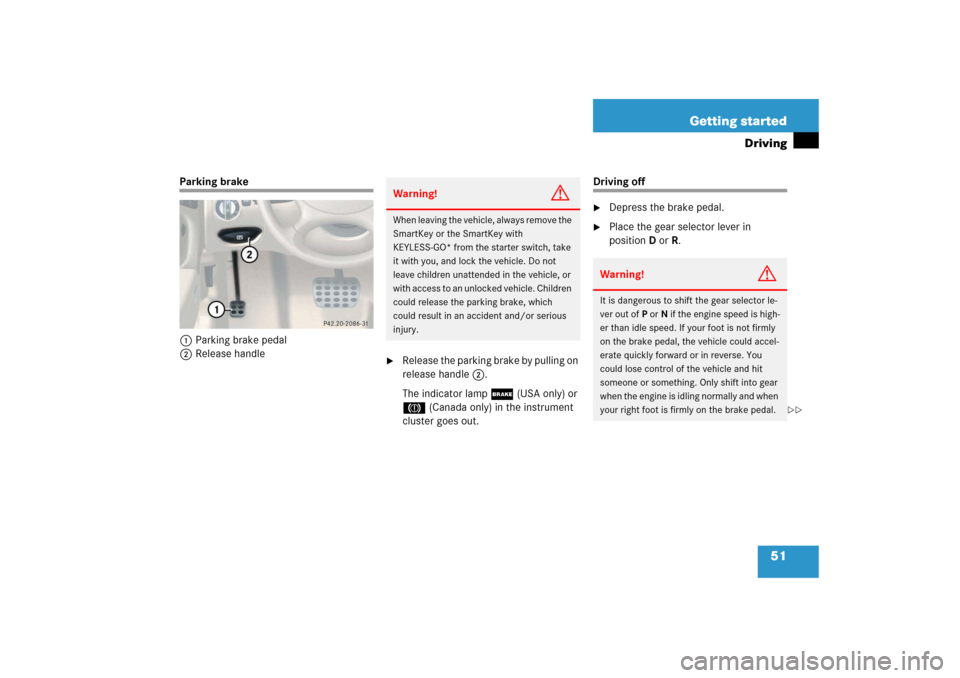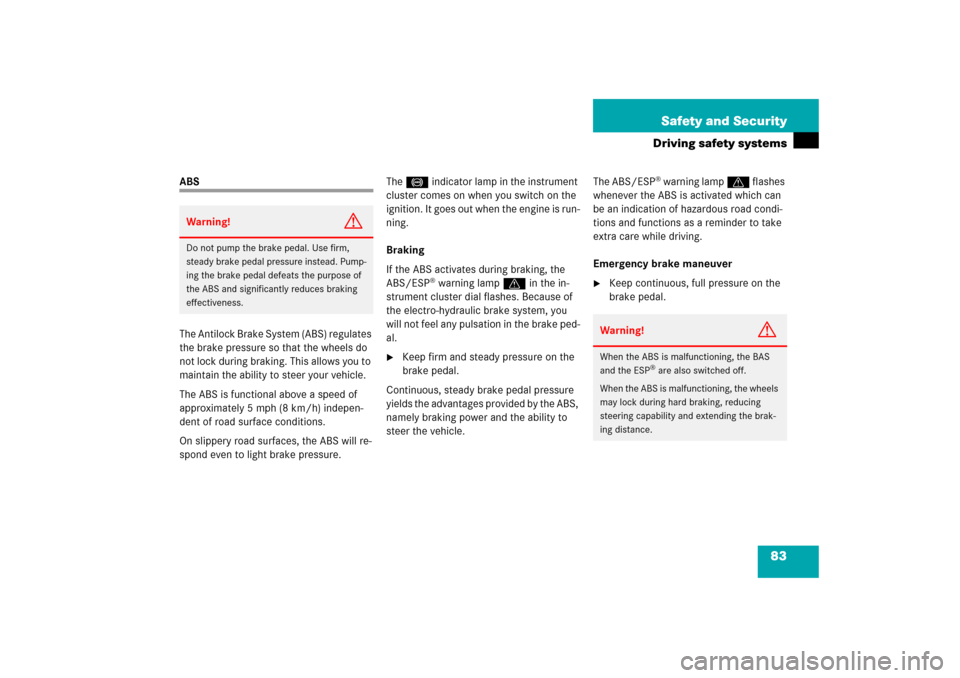Page 28 of 480
27 At a glance
Instrument cluster
Item
Page
5
Tachometer with:
133
AHigh beam head-
lamp indicator
129
úEngine malfunction
indicator lamp, USA
only
±Engine malfunction
indicator lamp,
Canada only
335
CRoll bar warning
lamp
339
-Antilock Brake Sys-
tem (ABS) indicator
lamp
333
Item
Page
1Supplemental
Restraint System
(SRS) indicator lamp
341
340
XCombination low tire
pressure/TPMS mal-
function telltale*
342
6
Right multifunction
display with:�
Gear selector lever
position
164
�
Outside temperature
display
134
�
Program mode
163
7
Fuel gauge with:AFuel reserve warning
lamp
338
Page 37 of 480

36 Getting startedUnlockingStarter switch positions SmartKey
Starter switch0For removing SmartKey
1Power supply for some electrical con-
sumers, such as seat adjustment
2Ignition (power supply for all electrical
consumers) and driving position
All lamps (except high beam headlamp
indicator lamp and turn signal indicator
lamps unless activated) in the instru-
ment cluster come on. If a lamp in the
instrument cluster fails to come on
when the ignition is switched on, have
it checked and replaced if necessary.If a lamp in the instrument cluster re-
mains on after starting the engine or
comes on while driving, refer to “Lamps
in the instrument cluster”
(
�page 332).
3Starting position
Warning!
G
When leaving the vehicle, always remove the
SmartKey or the SmartKey with
KEYLESS-GO* from the starter switch, take
it with you, and lock the vehicle. Do not
leave children unattended in the vehicle, or
with access to an unlocked vehicle. Unsu-
pervised use of vehicle equipment may
cause an accident and/or serious personal
injury.
iWhen you switch on the ignition, the in-
dicator and warning lamps (except high
beam headlamp indicator lamp and
turn signal indicator lamps unless acti-
vated) in the instrument cluster come
on. The indicator and warning lamps
(except high beam headlamp indicator
lamp and turn signal indicator lamps if
activated) should go out when the en-
gine is running. This indicates that the
respective systems are operational.iThe SmartKey can only be removed
from the starter switch with the gear
selector lever in position P.
Page 39 of 480

38 Getting startedUnlockingIgnition (or Position 2)�
Press the KEYLESS-GO start/stop but-
ton twice.
This supplies power for all electrical
consumers. All lamps (except high
beam headlamp indicator lamp and
turn signal indicator lamps unless acti-
vated) in the instrument cluster come
on.
For more information, see “SmartKey with
KEYLESS-GO*” (
�page 100).
For information on starting the engine us-
ing the KEYLESS-GO start/stop button,
see “Starting with KEYLESS-GO*”
(
�page 50).
iIf you now press the KEYLESS-GO
start/stop button once, the power sup-
ply is again switched off.
iWhen you switch on the ignition, the in-
dicator and warning lamps (except high
beam headlamp indicator lamp and
turn signal indicator lamps unless acti-
vated) in the instrument cluster come
on. The indicator and warning lamps
(except high beam headlamp indicator
lamp and turn signal indicator lamps if
activated) should go out when the en-
gine is running. This indicates that the
respective systems are operational.
Page 52 of 480

51 Getting started
Driving
Parking brake
1Parking brake pedal
2Release handle
�
Release the parking brake by pulling on
release handle2.
The indicator lamp;(USA only) or
3 (Canada only) in the instrument
cluster goes out.
Driving off�
Depress the brake pedal.
�
Place the gear selector lever in
positionD orR.
Warning!
G
When leaving the vehicle, always remove the
SmartKey or the SmartKey with
KEYLESS-GO* from the starter switch, take
it with you, and lock the vehicle. Do not
leave children unattended in the vehicle, or
with access to an unlocked vehicle. Children
could release the parking brake, which
could result in an accident and/or serious
injury.
Warning!
G
It is dangerous to shift the gear selector le-
ver out ofP orN if the engine speed is high-
er than idle speed. If your foot is not firmly
on the brake pedal, the vehicle could accel-
erate quickly forward or in reverse. You
could lose control of the vehicle and hit
someone or something. Only shift into gear
when the engine is idling normally and when
your right foot is firmly on the brake pedal.
��
Page 54 of 480
53 Getting started
Driving
Switching on headlamps
Low beam headlamps
The exterior lamp switch is located on the
dashboard to the left of the steering wheel.Exterior lamp switch1Off
2Low beam headlamps on�
Turn the exterior lamp switch to
position B.
The low beam headlamps come on.High beam
The combination switch is located on the
left of the steering column.
Combination switch1High beam
2High beam flasher�
Push the combination switch in direc-
tion of arrow 1.
The high beam headlamps come on.
The high beam headlamp indicator
A in the instrument cluster comes
on (
�page 27).
For more information, see “Lighting”
(
�page 123).
Turn signals
The combination switch is located on the
left of the steering column.Combination switch1Turn signals, right
2Turn signals, left�
Press the combination switch in direc-
tion of arrow1 or2.
The corresponding turn signal indicator
lampKorLin the instrument
cluster flashes (
�page 25).
Page 60 of 480

59 Getting started
Parking and locking
Parking brake
1Parking brake pedal
2Release handle�
Step firmly on parking brake pedal1.
When the engine is running, the indica-
tor lamp;(USA only) or3
(Canada only) in the instrument cluster
will be illuminated.
Switching off headlamps�
Turn the exterior lamp switch to posi-
tion M (
�page 53).
For more information, see “Exterior lamp
switch” (
�page 123).
Warning!
G
When leaving the vehicle, always remove the
SmartKey or the SmartKey with
KEYLESS-GO* from the starter switch, take
it with you, and lock the vehicle. Do not
leave children unattended in the vehicle, or
with access to an unlocked vehicle. Children
could release the parking brake and/or
move the gear selector lever from
positionP, either of which could result in an
accident and/or serious injury.
Warning!
G
Getting out of your vehicle with the gear se-
lector lever not fully engaged in positionP is
dangerous. Also, when parked on an incline,
positionP alone may not prevent your vehi-
cle from moving, possibly hitting people or
objects.
Always set the parking brake in addition to
shifting to positionP (
�page 164).
When parked on an incline, also turn front
wheels towards the road curb.
Page 65 of 480

64 Safety and SecurityOccupant safetyIn this section you will learn the most im-
portant facts about the restraint systems
of the vehicle.
The restraint systems are�
Seat belts
�
Emergency tensioning device
�
Airbags
�
Child seats
�
Child seat recognition
As independent systems, their protective
effects work in conjunction with each oth-
er.The 1 indicator lamp in the instrument
cluster comes on
�
for about 4 seconds when you turn the
SmartKey in the starter switch to posi-
tion 1 or press the KEYLESS-GO*
start/stop button once. It then goes
out briefly, comes on again and re-
mains lit until you start the engine, turn
the SmartKey to position 2 or press the
KEYLESS-GO start/stop button once
more (
�page 37).
�
for about 4 seconds when you turn the
SmartKey in the starter switch to
position 2 or press the KEYLESS-GO*
start/stop button twice (
�page 37).
�
for about 4 seconds when you start the
engine by turning the SmartKey in the
starter switch or by pressing the
KEYLESS-GO* start/stop button once
with the brake pedal depressed
(�page 49).
The 1 indicator lamp goes out shortly
after you start the engine. This shows that
the restraint systems are operational.A malfunction in the system has been de-
tected if the 1 indicator lamp
�
fails to go out after approximately
4 seconds
�
does not come on at all
�
comes on after the engine was started
or while driving
For more information, see the “Practical
hints” section (
�page 341).
iFor information on infants and children
traveling with you in the vehicle and re-
straint systems for infants and chil-
dren, see “Children in the vehicle”
(�page 76).
Page 84 of 480

83 Safety and Security
Driving safety systems
ABS
The Antilock Brake System (ABS) regulates
the brake pressure so that the wheels do
not lock during braking. This allows you to
maintain the ability to steer your vehicle.
The ABS is functional above a speed of
approximately 5 mph (8 km/h) indepen-
dent of road surface conditions.
On slippery road surfaces, the ABS will re-
spond even to light brake pressure. The - indicator lamp in the instrument
cluster comes on when you switch on the
ignition. It goes out when the engine is run-
ning.
Braking
If the ABS activates during braking, the
ABS/ESP
® warning lamp v in the in-
strument cluster dial flashes. Because of
the electro-hydraulic brake system, you
will not feel any pulsation in the brake ped-
al.
�
Keep firm and steady pressure on the
brake pedal.
Continuous, steady brake pedal pressure
yields the advantages provided by the ABS,
namely braking power and the ability to
steer the vehicle.The ABS/ESP
® warning lamp v flashes
whenever the ABS is activated which can
be an indication of hazardous road condi-
tions and functions as a reminder to take
extra care while driving.
Emergency brake maneuver
�
Keep continuous, full pressure on the
brake pedal.
Warning!
G
Do not pump the brake pedal. Use firm,
steady brake pedal pressure instead. Pump-
ing the brake pedal defeats the purpose of
the ABS and significantly reduces braking
effectiveness.
Warning!
G
When the ABS is malfunctioning, the BAS
and the ESP
® are also switched off.
When the ABS is malfunctioning, the wheels
may lock during hard braking, reducing
steering capability and extending the brak-
ing distance.